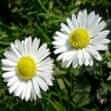Background
- Bellis perennis is a common European species of daisy. Although many other related plants are also called daisy, Bellis perennis is often considered the archetypal species. It is sometimes called common daisy or English daisy. It is native to western, central, and northern Europe, but is commonly found as an invasive plant in North America.
- The medicinal properties of Bellis perennis have been recorded in herbals as far back as the 16 century. John Gerard, the 16century herbalist, recommended English daisy as a catarrh (inflammation of mucous membrane) cure, as a remedy for heavy menstruation, migraine, and to promote healing of bruises and swellings.
- Infusions of the flowers and leaves have been used to treat a wide range of other disorders including rhinitis, rheumatoid arthritis, and liver and kidney disorders. An insect repellent spray has also been made from an infusion of the leaves. A strong decoction of the roots has been recommended for the long-term treatment of both scurvy and eczema, and a mild decoction may ease complaints of the respiratory tract.
- Bellis perennis has also been used traditionally for treating wounds. Chewing the fresh leaves is said to be a cure for mouth ulcers. In homeopathy, Bellis perennis is often used in combination with Arnica montana to treat bruising and trauma.
- Common daisy is widely used in homeopathy, but is currently only rarely used in herbal medicine. Although homeopathic dosing is generally recognized as safe (GRAS; U.S. Food and Drug Administration (FDA) designation), there is a lack of available scientific evidence to support claims for effectiveness related to the use of Bellis perennis. More research is needed in this area. Recent research has explored the possibility of using the plant in HIV therapy.
References
Natural Standard developed the above evidence-based information based on a thorough systematic review of the available scientific articles. For comprehensive information about alternative and complementary therapies on the professional level, go to . Selected references are listed below.
- Avato P, Vitali C, Mongelli P, et al. Antimicrobial activity of polyacetylenes from Bellis perennis and their synthetic derivatives. Planta Med 1997;63(6):503-507.
View Abstract - Bader G, Kulhanek Y, Ziegler-Bohme H. [The antifungal action of polygalacic acid glycosides]. Pharmazie 1990;45(8):618-620.
View Abstract - Desevedavy C, Amoros M, Girre L, et al. Antifungal agents: in vitro and in vivo antifungal extract from the common daisy, Bellis perennis. J Nat.Prod. 1989;52(1):184-185.
View Abstract - Glensk M, Wray V, Nimtz M, et al. Triterpenoid saponins of Bellis perennis. Scientia Pharmaceutica 2001;69-73.
- Gudej J, Nazaruk J. Flavonol glycosides from the flowers of Bellis perennis. Fitoterapia 2001;72(7):839-840.
View Abstract - Guneser S, Atici A, Cengizler I, et al. Inhalant allergens: as a cause of respiratory allergy in east Mediterranean area, Turkey. Allergol.Immunopathol.(Madr.) 1996;24(3):116-119.
View Abstract - Nazaruk J, Gudej J. Apigenin glycosides from the flowers of Bellis perennis L. Acta Pol.Pharm 2000;57(2):129-130.
View Abstract - Nazaruk J, Gudej J. Qualitative and quantitative chromatographic investigation of flavonoids in Bellis perennis L. Acta Pol.Pharm 2001;58(5):401-404.
View Abstract - Oberbaum M, Galoyan N, Lerner-Geva L, et al. The effect of the homeopathic remedies Arnica montana and Bellis perennis on mild postpartum bleeding--a randomized, double-blind, placebo-controlled study--preliminary results. Complement Ther.Med 2005;13(2):87-90.
View Abstract - Schopke T, Hiller K, Wray V, et al. Triterpenoid saponins from Bellis sylvestris, I. Structures of the major deacylsaponins. J Nat.Prod. 1994;57(9):1279-1282.
View Abstract - Schopke T, Wray V, Kunath A, et al. Bayogenin and asterogenic acid glycosides from Bellis perennis. Phytochemistry 1992;31(7):2555-2557.
View Abstract - Schopke T, Wray V, Kunath A, et al. Virgaureasaponin 2 from Bellis perennis L. Die Pharmazie 1-1-1990;45:870-871.
- Siatka T, Kasparova M. [Seasonal changes in the hemolytic effects of the head of Bellis perennis L.]. Ceska.Slov.Farm 2003;52(1):39-41.
View Abstract - Siatka T, Kasparova M, Dusek J. Seasonal variation in haemolytic activity of Bellis perennis L. leaves and roots. Folia Pharmaceutica Universitatis Carolinae 2002;85-89.







